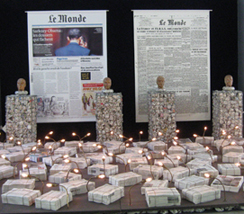Le Monde : quoi faire?

Le Monde building
Le Monde was a daily national newspaper. Many considered it the French paper of record, and in 2006 it had a circulation of some 350,000. Founded in December 1944 after the German army was driven from Paris, the paper by the 21 st century had a reputation as politically moderate. In general, Le Monde prided itself on being a paper of ideas. It strove to analyze and interpret the news, rather than simply to report it. Le Monde was an afternoon paper, publishing at noon with the following day’s date on it. As one editor puts it wryly: “So we are always a little bit ahead or a little bit late!” [1]
The paper had an unusual organizational structure. Its journalists owned the publication and elected their own top editors and management. An executive editor led the paper, but a quartet of deputy editors, known as le redaction (the editorial), ran the paper on a daily basis. In early February 2006, Executive Editor Gerard Courtois was out of town. The deputy editors were Michel Kajman, Laurent Greilsamer, Sylvie Kauffmann, and Patrick Jarreau. They shared authority equally, and rotated the person in charge for any given edition. The editors met three times daily—at 7:30 a.m., at noon, and at 5 p.m.—to discuss what would go in the next day’s paper. The morning meeting was quick—a digest of overnight developments. The noon meeting was the largest, included reports from section editors, and covered both daily articles and long-term projects. The afternoon meeting tended to focus on technical questions—placement and space issues. The paper closed every day at 10:30 a.m.
While the deputy editors’ team sought input from all departments, significant decisions, says Deputy Editor Greilsamer , “are taken by a very few people, especially in this kind of matter. We have to consult, but the more consequential the decision,” the fewer the decision makers. [2] On the other hand, the deputies enjoyed unusual unanimity of views. Editorial meetings could be lively, but rarely involved deep-seated philosophical differences. Explains Greilsamer:
We are people who have known each other for about 20 years, in general, who live in the same office for 3–4 years, who can read each other. We know each other’s sensibilities, our reactions, the ways of analyzing. This is all to say we don’t need to sit down at a table and to ask, “What do we think? What do you think? Why do you think that?” In a way, we know in advance, and almost intuitively… We know each other by heart.
Le Monde had covered the growing cartoon controversy thoroughly. But with the appearance of the cartoons across Europe, it was time to bite the bullet. Should Le Monde reproduce the cartoons—which could be seen as support of free speech and media colleagues? Or should it not—out of respect for the large Muslim population in its readership area, and to avoid fanning the sectarian embers still smoldering in Paris? There were several aspects to consider.
Legal . Under French law, group defamation was both a criminal and a civil offense. What’s more, re-publication of a defamatory item was considered a new offense. An 1881 Freedom of the Press law governed the criminal charges: Article 29 criminalized group libel and re-publication, while Article 33 termed hate speech group defamation and criminalized hate speech against religious, ethnic, and minorities. In 2006, the punishment was six months imprisonment and a fine of €22,500 for each insult. There was likely little legal risk for Le Monde in republishing the cartoons, but it wanted to make sure it stood on solid legal ground.
Competition . A second consideration was competition. What were other papers doing? Le Monde compared itself to such high-brow publications as the International Herald Tribune , the Guardian , or the Frankfurter Allgemeine Zeitung . They paid attention as well to what less serious papers like Die Bild or France Soir were publishing, but did not consider them direct competitors. Last, but not least, were readers. Did the newspaper have an obligation to print the cartoons in order to serve its readers?

Le Monde newspaper display
During the noontime editorial meeting on February 1, the editorial leaders debated the matter at some length. There was no great enthusiasm for reproduction, but it seemed equally impossible not to run something. Then Deputy Editor Kajman had an idea that might buy at least some time. Cartoons had a long and venerable history at Le Monde . What if, instead of running the original and offending cartoons, they commissioned their own—an illustration of the controversy instead of the controversial cartoons themselves?
The paper had four cartoonists on staff, but one was an obvious choice for this assignment. Jean Plantureux (known as Plantu) was an award-winning political cartoonist with some 30 years’ experience. “Plantu is the cartoonist number one,” says Editor Greilsamer. “In the hierarchy, he’s the best, and it’s always he who draws for Page One.” At the time, Plantu’s cartoons appeared on the front page, above the fold. He did not decide on his own topics, but was assigned them. The group decided to ask him to do something on the controversy. Kajman volunteered to track down Plantu and give him a call.
[1] Author’s interview with then-Deputy Editor Sylvie Kauffmann in Paris, on May 21, 2010. All further quotes from Kauffmann, unless otherwise attributed, are from this interview.
[2] Author’s interview with Laurent Greilsamer in Paris, on May 20, 2010. All further quotes from Greilsamer, unless otherwise attributed, are from this interview.